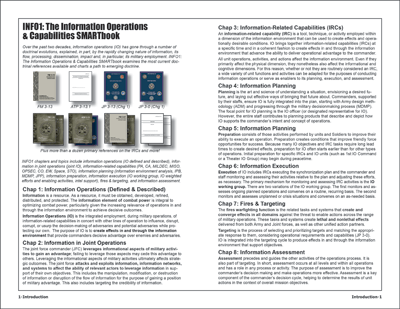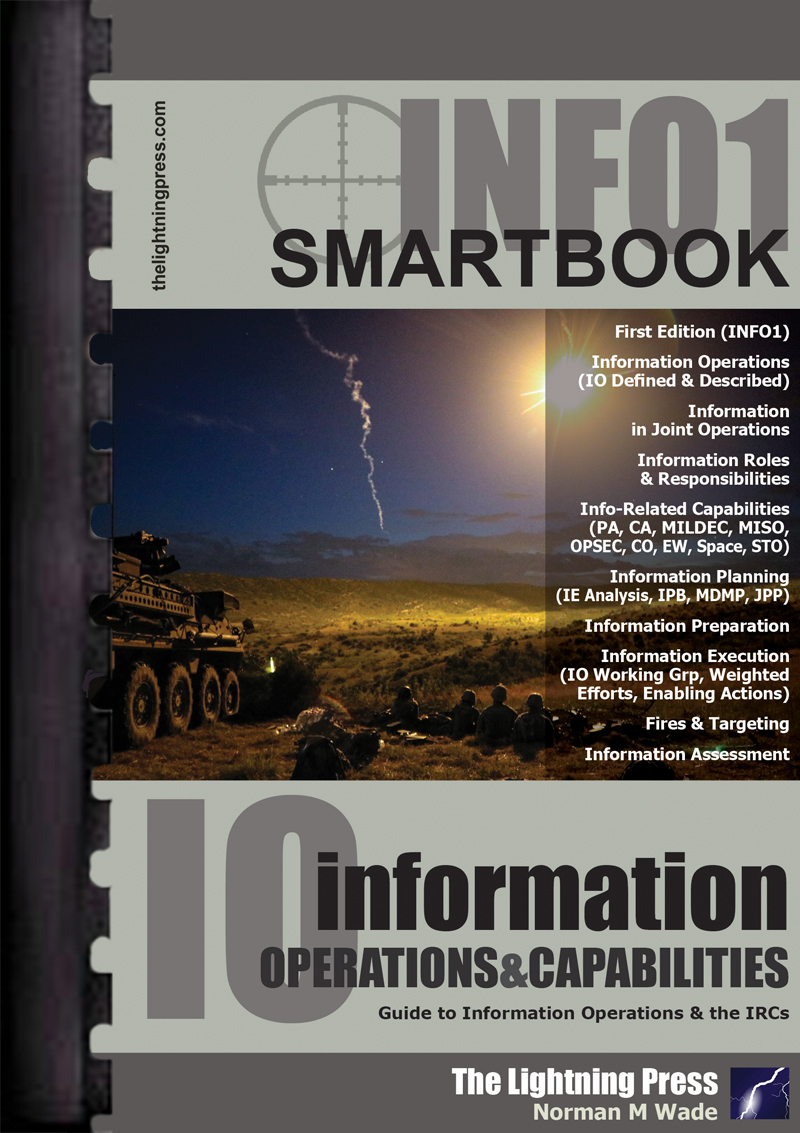Gaining the “information advantage” to achieve “decision dominance” is an emerging doctrinal concept with regard to operations in the information environment. While not currently defined in joint or service doctrine, components of the concept are similar to those found in FM 3-0’s discussion of “position of relative advantage”, discussed further below.

Over the past two decades, information operations (IO) has gone through a number of doctrinal evolutions, explained, in part, by the rapidly changing nature of information, its flow, processing, dissemination, impact and, in particular, its military employment. INFO1: The Information Operations & Capabilities SMARTbook examines the most current doctrinal references available and charts a path to emerging doctrine.
Position of Relative Advantage
A position of relative advantage is a location or the establishment of a favorable condition within the area of operations that provides the commander with temporary freedom of action to enhance combat power over an enemy or influence the enemy to accept risk and move to a position of disadvantage (ADRP 3-0). Positions of relative advantage occur in all domains, providing opportunities for units to exploit. Commanders maintain momentum through exploitation of opportunities to consolidate gains, and they continually assess and reassess friendly and enemy effects for future opportunities. A key aspect in achieving a position of advantage is maneuver, the employment of forces in the operational area through movement in combination with fires to achieve a position of advantage in respect to the enemy (JP 3-0).
Positions of relative advantage are usually temporary and require initiative to exploit. While friendly forces are seeking positions of advantage, enemy forces are doing the same. There are multiple forms of positional advantage that provide opportunities to exploit. Some are considerations that should be understood when formulating tactical and operational concepts, while others are goals that can be worked towards as a means of destroying or defeating the enemy and achieving the overall purpose of the operation.
Examples of positional advantage include—
• Physical and geographical (including strategic positioning, sanctuary, and control of key terrain)
• Combat power and warfighting function overmatch (including range, lethality, precision, and mass)
• Relationships and influence (including allies, interoperability, access, and indigenous forces)
• Legitimacy, ideas, and popular perception (including what is good versus bad, accepted versus opposed, and a believable narrative)
• Time (including speed of recognition, speed of decision making, speed of action, and operational tempo)
• Freedom of action (including secure lines of communications, standoff, depth, access to cyberspace, maritime and air enablers, and friendly A2 & AD measures)
• Moral (including alignment of words & deeds, just & unjust, international support)
• Will (including doing what must be done, continuing as long as it takes, and maintaining support from domestic leaders)
Relative positional advantage is something to gain, protect, and exploit across all domains. Combining positional advantages across multiple domains during each phase of operations provides opportunities for exploitation through maneuver. Physical or geographic positions of relative advantage are often identified first as decisive points and then depicted in operational graphics as objectives. The greater the number of positions of advantage a commander can generate, the increased number of dilemmas that commander can present to an enemy. The combination of positional advantages change over time relative to changes in the OE, and this change includes how the enemy reacts to friendly forces’ activities. It is the exploitation of positions of advantage through maneuver which deters, defeats, or destroys an enemy. Leaders at every echelon are expected to display the initiative necessary to assume prudent risk while taking timely advantage of opportunities that present themselves under ambiguous, chaotic conditions. It is not always possible to understand those opportunities before they arise, so it is important that units have a command climate that rewards those who make decisions and act boldly in the absence of orders.
 This article is an extract from “INFO1: The Information Operations & Capabilities SMARTbook (Guide to Information Operations & the IRCs)” by The Lightning Press. Download a free PDF sample and learn more at: “INFO1: The Information Operations & Capabilities SMARTbook (Guide to Information Operations & the IRCs).”
This article is an extract from “INFO1: The Information Operations & Capabilities SMARTbook (Guide to Information Operations & the IRCs)” by The Lightning Press. Download a free PDF sample and learn more at: “INFO1: The Information Operations & Capabilities SMARTbook (Guide to Information Operations & the IRCs).”
Browse additional military doctrine articles in our SMARTnews Blog & Resource Center.
About The Lightning Press SMARTbooks. Recognized as a “whole of government” doctrinal reference standard by military, national security and government professionals around the world, SMARTbooks comprise a comprehensive professional library. SMARTbooks can be used as quick reference guides during operations, as study guides at education and professional development courses, and as lesson plans and checklists in support of training. Browse our collection of Military Reference SMARTbooks to learn more.











































